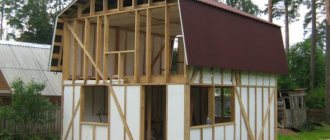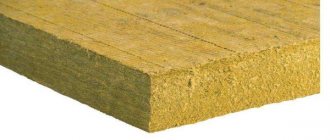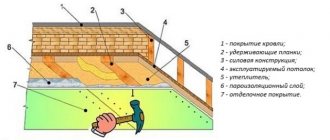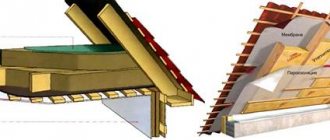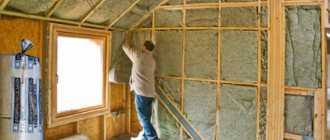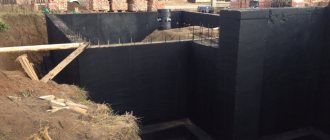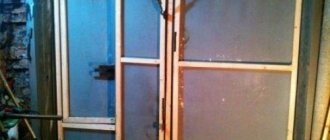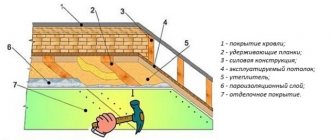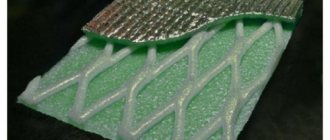MesterulManole
11050 0 3
MesterulManole September 1, 2016Specialization: many years of experience in finishing works of residential and office premises, dachas, country cottages, etc. Hobby: cycling in all its forms
Thermal insulation of the internal volume of a metal container with mineral wool
Hello. Today I plan to talk about how to insulate a container outside or inside yourself using available materials . The topic of the article is of considerable interest, since metal containers are increasingly used as modules for the construction of garages, basements, cottages and even full-fledged residential buildings.
How to insulate a container from the inside
For the construction of premises, marine Dry Containers are usually used - these are sealed metal boxes 20 and 40 feet long, i.e. they are roomy enough to comfortably accommodate several people at once. But the problem is that metal is a material with high thermal conductivity, which means that in winter it will be very cold in this iron room, and in summer, on the contrary, it will be too hot. How to insulate a container for housing from the inside?
You can make thermal insulation with expanded polystyrene foam by contacting a specialized company that professionally deals with insulation of various buildings.
This option is the most energy efficient - a layer of polystyrene foam 5 cm is similar in its thermal insulation properties to a one and a half meter brick wall. It does not create dew points, because... the coating is monolithic and integral. Additionally, the effect of a thermos is obtained - heat does not leak out at all, and the room from one heater warms up to a comfortable temperature in just half an hour. In addition, this material is indifferent to moisture, which makes it possible to apply it to the floor of the room. This is especially true if the container stands directly on the ground, without a foundation slab.
The second option is to do the thermal insulation of the container yourself using mineral wool. Its layer should be at least 10-12 cm .
Do not lay the material directly on the floor - it absorbs moisture well, and an accidentally spilled glass of water will gurgle under your feet for a long time.
Work order
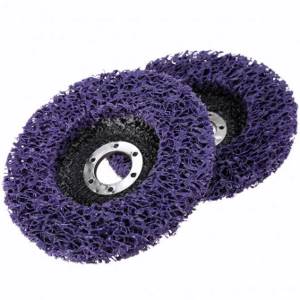
Purple coral for removing rust before insulation
The procedure for turning an ordinary steel box into a warm container includes several stages. Before insulating a container for permanent residence, you will need to carry out preparatory measures. You should decide in advance on the method of insulation (outside or inside).
Preparatory stage
The essence of preparation is to carefully examine the container for traces of dirt and rust on its surfaces. The former are simply washed off with water, and traces of corrosion, if possible, are cleaned in any convenient way. Typically, a grinder with a metal brush attachment is used for this. Traces of rust are removed from the outside and inside, after which they proceed to coating the metal with a layer of protective primer.
After the primer has dried (after about 2 hours), you can proceed to painting the surfaces, which will reliably protect the metal from moisture and damage. A second layer is applied over the dried paint. Upon completion of these procedures, they proceed to the main insulation operations.
Stages of interior work
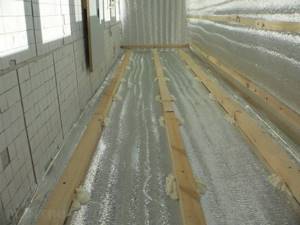
Insulating a container from the inside is possible when the loss of part of the volume of the internal space does not matter. The work carried out in this case is divided into two stages: finishing of the side surfaces and thermal insulation of the ceiling. When carrying out them, the walls should be insulated first. To do this, a wooden sheathing consisting of bars of a suitable size is attached to them. Then, plates of the selected heat insulator (expanded polystyrene, for example) are placed in the spaces between them. To enhance the insulation effect from cold air masses, it is additionally covered with a layer of penofol.
The ceilings are insulated in the same way as the walls, after which everything is sheathed with plasterboard sheets.
How to insulate a container from the outside?
Since metal can easily withstand even 40-degree frost, it is less advisable to insulate the container from the outside than from the inside. The only advantage of this option is the preservation of the internal space of the room.
For external insulation of container walls, you can use foam plastic of considerable thickness, but in this case, when attaching it with “umbrellas,” there is a risk of dew points appearing at the fastening site. By using expanded polystyrene sheets that can be mounted on foam, this problem can easily be avoided.
Experts consider foam polystyrene to be the optimal option for external insulation of containers. It reliably insulates walls, protects metal from aggressive external factors and corrosion.
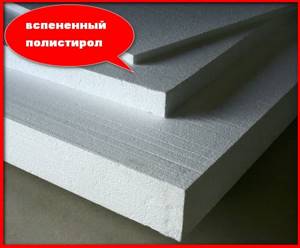
Is it possible to turn sea containers into full-fledged housing?
Certainly. As mentioned above, the area of one forty-foot Dry Container is 28 m2 . Thus, if you correctly combine only four pieces, you can get a house with an area of 112 m2 - a real full-fledged cottage. Moreover, if the structures are compared vertically, you can get a two-story or three-story building (more than three floors cannot be built, since the metal may not withstand such pressure).
The main advantage of buildings made from sea containers is that the house can be assembled like a construction set - using a grinder we remove unnecessary side or end walls and get the configuration that we need or is convenient for.
Some craftsmen who are particularly demanding in terms of aesthetics manage to cut out shaped (for example, in the form of arches) openings between rooms.
Such a designer house made from a sea container is convenient for living if it is properly insulated. It meets fire and sanitary standards. A building assembled in this way can easily be connected to all necessary communications - water supply and sewerage (both autonomous and centralized), electrical wiring installed and connected, and even centralized heating installed.
Features of external insulation
If it is important to maintain the volume of space, insulation is carried out from the outside
Insulating a house from containers from the outside is in demand in situations where it is important to preserve their internal volume without any changes. For external work, foamed polystyrene is usually used, which protects metal well from corrosion, or thick sheets of foam.
In the second case, special hardware (“umbrellas”) will be required to fasten the material, the use of which poses the threat of the formation of cold bridges. This lack of material must be taken into account when insulating, for which risk areas are additionally treated with liquid heat insulators or sealed with foam.
Pros and cons of container houses
Architects from different parts of the world are experimenting with shipping containers, creating individual designs for their buildings, and offering more and more new ideas.
The popularity of this type of housing is associated with great advantages. Positive sides:
- Relatively low financial costs for construction. This despite the fact that the standard area of such a house is 30 square meters.
- Reliable design that provides maximum protection against unauthorized entry.
- Building a house and insulating it takes a short amount of time.
- You can use a strip foundation, which also seriously reduces construction costs.
- A container house is not susceptible to natural phenomena such as floods or earthquakes.
- Such a building stands out noticeably against the general background.
- Can be used in conditions of heavy snowfall.
- There is a possibility of installation under an inclined plane.
- Suitable not only as temporary housing, but also as a separate permanent home.
Negative sides:
- Containers are intended for sea transportation. To protect cargo from atmospheric agents, a special toxic material was applied to the surface of the containers. Accordingly, before moving into the container, it is necessary to clean it.
- The walls of the container are not intended for habitation. They heat up quite quickly and also cool down quickly at warm and cold temperatures, respectively.
- The structure requires special care, since the walls are susceptible to corrosion.
Required materials and tools
Penoplex does not allow moisture to pass through, so it is recommended for insulating metal structures.
To organize and implement insulation of a sea container from the inside, you will need to prepare:
- insulation material of the selected type (expanded polystyrene, for example);
- wooden beam 5x5 cm and dowels;
- tape, primer and plastic film;
- mounting foam, paint and sealant.
In addition, it is necessary to purchase plasterboard sheets, as well as chipboard or fiberboard blanks.
Large tools will require a grinder, an electric drill and a screwdriver. In addition, you need to prepare the following toolkit:
- screwdrivers;
- yardstick;
- device for applying polyurethane foam and sealant;
- dowels;
- brush, hammer, sharp knife and building level.
You will also need a pencil or colored felt-tip pen for marking.
When working, you should use protective equipment for the skin of your hands and face - a respiratory mask, gloves and goggles.
How to insulate a living room floor
Before insulating the floor in the container, first lay a thick film for vapor barrier. After its arrangement, logs are installed in increments of at least 0.9 m. Then foam plastic or other high-quality insulating material from those described above is laid. If there are gaps, they are filled with polyurethane foam so as not to leave cold bridges. Then the floor is covered with moisture-resistant material. It can be plywood, chipboard or fiberboard.
Note! Do not choose cheap mineral wool of dubious quality and from an unverified manufacturer. Usually the reason for the reduction in price is a deviation from the manufacturing technology. Therefore, such a material can quickly lose its thermal insulation properties.
The next stage of floor insulation is laying decorative flooring. After this, the floor around the perimeter of the container is insulated with sealant or polyurethane foam. Upon completion of the work, plinths are installed.
Performance
In most cases, polystyrene foam or mineral wool is used as wall insulation from the inside.
The process of insulating a container with your own hands is as follows:
- The selected insulation is attached to a pre-fabricated frame. It is best to use self-tapping screws for this. It is important not to forget to make holes in the lower and upper edges of the walls for condensation to escape.
- After the main thermal insulation work has been carried out, it is necessary to lay a vapor barrier layer. Reinforcing film is perfect for this.
- After the walls are insulated, it is worth moving on to the ceiling and floor. To do this, you can use basalt wool with high density and heat capacity.
Preparing for insulation
Let's consider point by point what work needs to be done to insulate a container for housing:
- Considering that the container is made of perishable materials, it must be prepared in advance. It is necessary to carefully inspect all surfaces for rust, dents and other damage.
- If rust is detected, it is necessary to clean the damaged areas with sandpaper or a grinding machine, if available.
- Before starting the insulation process, it is recommended to prime and paint the walls. If this is not possible, then it is necessary to at least carry out similar work on the damaged areas of the container.
- Before starting insulation work, it is necessary to find and make load-bearing supports for the house. This will require three beams of approximately 50 mm each. They must be made of dry wood. A frame is assembled from blanks around the perimeter of the entire container.
Polyurethane foam
Polyurethane consists of 90% air.
And, as everyone knows, it has low thermal conductivity. That is why this material is good to use as foam insulation. The finish made from it will be vapor and moisture resistant.
But the process of applying polyurethane to walls should only be carried out by a professional. This material must be applied as tightly as possible, and without appropriate experience this will be difficult to do.
For people who like to do everything with their own hands, building a house from a container and insulating it will be an easy and interesting task. Good results can be achieved with modern materials, expert advice and your own creative thought.
Watch the video, which shows in detail the process of insulating a container for housing:
Expanded polystyrene
Expanded polystyrene in slabs is a new generation of foam plastic. It has a higher structure density. Two layers of this material create a seamless vapor barrier, which in turn will prevent the formation of condensation on metal walls.
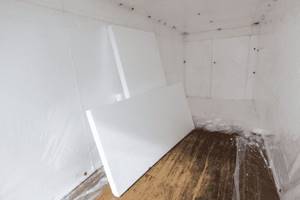
Insulation with modern foam plastic
How to thermally insulate a container house with polystyrene foam boards? To do this, during the construction of the sheathing, cells are made equal to the width of the foam slab, which is placed in the cells.
Mineral wool
The “pie” of mineral wool insulation is durable and fireproof. Cotton wool has biological and chemical resistance. Metal elements in contact with mineral wool are not subject to corrosion. When installing thermal insulation indoors, mineral wool insulation is covered with a membrane film.

Insulation with mineral wool
This insulation has low vapor permeability, so all condensation will be concentrated in the layers of mineral wool. The film is attached using a construction stapler or expanding anchors.
Advice! If you buy foiled mineral wool, you can do without a vapor barrier film.
If you do not have experience in insulating residential premises, be sure to watch the video on how to properly insulate a container before getting started. After insulation, the house is ready for covering with plasterboard or other materials.
Table of characteristics of materials for thermal insulation of metal containers.
| Name | Properties | Features of insulation |
| Mineral wool | Fungus and mold do not form in the fibers. | You can hide wiring in mineral wool. The installation of these materials begins with the walls, and only then the ceiling is insulated. It is necessary to make holes for condensate to escape. |
| Expanded polystyrene | Has low thermal conductivity. Has the best ratio: price - quality. | |
| Spray polyurethane foam | Durable in use and resistant to wear; | The insulation layer should be continuous. |
How to insulate the ceiling and walls
Liquid polyurethane foam does not leave cracks or air pockets, which extends the service life of steel.
One of the best materials that can be used to insulate surfaces with a wavy structure is polyurethane foam, which hides even large irregularities well. The attractiveness of this insulation is explained by its following advantages:
- ease of installation of the material;
- environmental friendliness;
- tight fit to the walls (without the formation of cracks);
- reliable thermal insulation.
The use of materials of this class reduces convective flows and virtually eliminates the possibility of condensation formation. In addition, extruded polystyrene foam is used to insulate a sea container for living. This material is not inferior in its performance to polyurethane foam, differing from it only in price.
You can also insulate a container for housing with ordinary mineral wool, but its use is limited in conditions of high humidity (in sea containers, for example). In the presence of moisture vapor, this insulating material quickly becomes saturated and begins to rot over time.
Insulation of floors
Logs are installed on the floor, into which insulation is laid - mineral wool, penoplex.
To insulate the floor in a residential container, you need to carry out the following work:
- A dense polyethylene film is laid on the base, providing complete vapor insulation.
- A thermal insulation layer is placed on top, formed on the basis of foam plastic, for example.
- Before laying it, a frame is made of beams (logs), laid across the container in increments of approximately 60-70 cm.
- To fasten the beams, a set of self-tapping screws is used, screwed into each board in at least 3-4 places.
- The insulation is placed in the spaces between the joists so that it fills them to the entire height of the beam and is distributed as densely as possible.
- The remaining gaps must be sealed with polyurethane foam.
The material is covered on top with multi-layer moisture-resistant plywood 10 mm thick, which protects the heat insulator from deformation and damage.
Before installing the baseboards, all gaps around the perimeter of the floor base are treated with sealant or polyurethane foam.
Block containers RosModule description
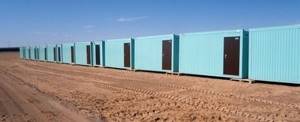
RosModul block containers have numerous advantages over similar economy class products. The production of RosModul block containers is located in St. Petersburg, not far from the Ring Road.

Dimensions and specifications of block containers Block container type RosModul
| TYPE BC | EQUIPMENT | Outside, maximum | Inside, minimal | Weight, kg | ||||
| Length, mm | Width, mm | Height, mm | Length, mm | Width, mm | Height, mm | |||
| STANDARD | Basis | 6000 | 2430 | 2590 | 5768 | 2198 | 2295 | 2100 |
| Standard | 6000 | 2430 | 2590 | 5768 | 2198 | 2295 | 2200 | |
| Lux | 6000 | 2430 | 2800 | 5568 | 1998 | 2405 | 2600 | |
| Sandwich* | 6000 | 2430 | 2590 | 5750 | 2180 | 2280 | 2200 | |
| Collapsible | 6055 | 2435 | 2590 | 5800 | 2180 | 2260 | 2200 | |
| NORTH 200 mm | 6000 | 3000 | 3000 | |||||
| TECHNO sandwich | 6000 | 2430 | 2590 | 5750 | 2180 | 2270 | 2200 | |
| Sanitary | 6000 | 2430 | 2590 | 5768 | 2198 | 2295 | 2500 | |
* - with a sandwich panel thickness of 100 mm.
| Options | ||||
| Insulation of walls/floor/ceiling | 100mm/100mm/100mm | 100mm/100mm/100mm | 150mm/150mm/150mm | 150mm/150mm/150mm |
| external cladding | profiled sheet S-8 0.5 mm | profiled sheet S-8 0.7 mm | ||
| Height | 2.59 m | 2.59 m | 2.59 m | 2.8 m |
| Wall thickness | 116 mm | 116 mm | 216 mm | 216 mm |
| Frame | Special bent profile 3 mm thick | Hot-rolled steel channel 12P, corners 80x80x6 mm | ||
| floor joists | timber 100x40 | channel 100x50, additional lathing | width 100x50x3 mm, every 600 mm, additional lathing | width 100x50x3 mm, every 600 mm, additional lathing |
| flooring | DSP 16 mm | DSP or plywood - 2 layers | ||
| floor covering | household linoleum brown | wear-resistant linoleum | wear-resistant linoleum | Laminate or homogeneous linoleum |
| Wall decoration | 8 mm laminated chipboard, Galliano oak color, aluminum profile layout. | FORA finishing panels – painted or laminated with a film based on gypsum plasterboard, SML. | ||
| Ceiling finishing | PVC panel | 8 mm chipboard, white, aluminum profile layout | “Armstrong” or FORA finishing panels – painted or laminated with a film based on gypsum plasterboard, SML | |
| Electrics | External in cable channel | Hidden inside the walls | ||
| Window | PVC, tilt and turn, single chamber 940x1140 mm | PVC, tilt and turn, two-chamber 940x1140 mm | PVC, tilt and turn, two-chamber 1840x1140 mm | |
| Which configurations are suitable for different climatic zones? | ||||
| Regular "O1" | ||||
operating temperature up to -45ºС; for climatic subregions IB, IIA and IIIA or “O2” for subregions IIB, IIB, IIG, IIIB and IIIB
operating temperature from +45ºС to -55ºС for climatic subdistricts (according to SNiP 2.01.01-82) IA, IB, IG, ID.
Thermal insulation
Mineral or basalt wool up to 150 mm thick with a design heat transfer resistance of structures up to Rtr = 4.16 m 2 * 0 C/W (air temperature up to -50 0 C). In northern options, additional insulation may be used.
Loads
Standardized loads according to GOST 22853-86: on the roof up to 150 kg/m2, on the floor up to 200 kg/m2. In RosModule containers, the loads in the standard version exceed the normalized ones by two times. For technical containers, additional reinforcement of the floor with steel beams is possible.
Engineering.
Electrical equipment according to the project. Additionally, any engineering systems are installed: heating, water supply and sewerage, ventilation, plumbing equipment, etc.

The modular containers produced by the Mobile Buildings Plant have the appropriate certificates and licenses (see GOST section). Upon delivery, block containers are equipped with a product passport and operating instructions. A marking plate with designation in accordance with GOST 22853-83 is applied to the product.
Sheathing of the block container with profiled galvanized and painted polymer coating sheet C-8 0.5 mm thick with external shaped elements.
Standard design: walls laminated with laminated chipboard in Galiano oak color, 8 mm thick with aluminum layout, ceiling with white PVC panels (chipboard), heterogeneous linoleum floor on waterproof 16 mm chipboard, plastic skirting boards.
Any custom design is possible, including interior finishing, ensuring the required degree of fire resistance of the structure .
Standard finishes can be viewed at this link.
To identify the product in accordance with GOST 22853-86, a metal marking plate is applied to all block containers containing:
- name and address of the manufacturer
- name and specifications (technical conditions) of product release
- mobility index M (mobile)
- type of building, block container (container with running gear - K1, container with removable running gear - K2, container without running gear - K3, collapsible from block containers - C1, collapsible from flat and linear elements - C2, collapsible combined - C3)
- design of the building, block container (usual - O1 or O2, northern - C)
- weight of the building, block container, kg
- serial number (order number)
- date of manufacture of a mobile building (block container) Rental of block containers. We provide block containers for rent for a period of 1 month.
What else determines the price of a container house?
- the number of containers used – a building made from one container unit will cost less, but if you buy several at once you can get a good discount;
- condition - the price varies greatly depending on whether you are purchasing a new container or a previously used one;
- the need for additional services - whether you insulate the container yourself, as well as carry out all the necessary communications (electricity, plumbing and sanitation, heating) or contact a specialized company, its final cost will also depend.
The only disadvantages of container construction include the fact that it is impossible to build a tall (more than three floors) house from containers and its urban character - it is difficult to beat the rectangular shape. Although such a strict geometric appearance is precisely what attracts those who decide to build a house from containers.
Where else can you use insulated containers?
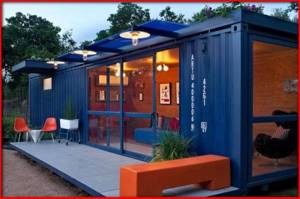
The scope of application of marine packaging is very wide - from a seasonal summer cottage shed for storing garden tools to permanent housing. In Europe, budget hotels, fast food establishments and even public transport stops are built from it. And as cabins on construction sites, staff and residential trailers on shifts, etc. they are simply irreplaceable. This is due to the fact that corrugated steel is a very durable, weatherproof material. The container, even without additional external finishing, can last for decades.
One of the most popular is block container bcode 01. It is a container made of galvanized metal, insulated and lined with chipboard. It can be used as living quarters for shift workers or as a change house for security at a checkpoint.
The container is well insulated, the inside is lined with particle boards that are pleasant to the touch, and is cozy and comfortable.
Advantages of a country container
The metal block container for the dacha is a relatively recent invention. Despite its young age, the design has proven itself in operation. Here are just some of the benefits of using a block container:
- Fast production and installation times. This technology is popular in the USA, where the production of residential containers was established back in the 1990s.
- The residential module can serve as a place of residence for a long time without requiring special care;
Comfort in a country container
Many experts predict a bright future for modular container technology. The standard design can be used properly for at least 25 years. At the same time, the strength is practically no different from similar indicators of a brick house;
Expansion of space. The design allows the installation of additional modules, or the dismantling of already installed ones. Thanks to the durable frame, if necessary, you can easily equip an additional room or floor;
The container block is suitable for living in the warm season. If you install additional communications and heating, you can live comfortably in such a room even in winter.
Is a sea container suitable for arranging a cellar?
The container is a sealed container. If you insulate it correctly, you will get a thermos. Therefore, some summer residents and owners of private houses have a question: is it possible to adapt the structure to a cellar?
It is difficult to give a definite answer to this question. It all depends on the type of soil and the depth of soil freezing. Experts are inclined to believe that in areas where light sandy and sandy loam soils predominate, this is quite possible, but only if the container is well anchored (and it does not “float” to the surface). Naturally, in this case it will be necessary to take care of additional thermal insulation of the structure. For heavy loams, it is not recommended to use a container for arranging a cellar - lateral soil pressure can deform it. This, in turn, is fraught with a violation of the integrity of the structure and deterioration of its thermal insulation.
Insulation of wooden and refrigerator cars
To insulate wooden cars, a beam is hammered onto their inner surface, between which foam is foamed. Spraying is carried out in such a way that there is a small space between the edge of the polymer and the sheathing for air ventilation. The hardened foam is covered with any finishing material - boards, plywood. After insulation and refurbishment, such trailers can be used as residential and technical premises.
When insulating isothermal (refrigerated) cars and tanks, a layer of polyurethane foam is placed in the enclosing structures located between the inner and outer casing by pouring, which forms a kind of thick shell that does not let heat and cold in.
The use of polyurethane foam makes it possible to do without protective films, as well as laying asbestos and other fiberglass fire-retardant materials, which creates good savings.
How to calculate the approximate area of a container
Since the cost of the work carried out depends on the area of the surface being sprayed, to insulate container buildings you need to know the dimensions of the modules
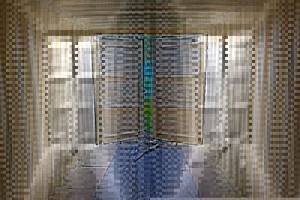
| Dimensions | Container type | ||||||
| standard 20 feet | high 20 feet | standard 40 feet | high 40 feet | tall, wide 40 feet | tall, wide 45 ft 2.75 m | high, wide 45 ft 2.90 m | |
| external dimensions | |||||||
| height, mm | 2591,00 | 2896,00 | 2591,00 | 2896,00 | 2750,00 | 2896,00 | |
| length, mm | 6058,00 | 12192,00 | 13716,00 | ||||
| width, mm | 2438,00 | 2500,00 | |||||
| inner dimensions | |||||||
| height, mm | 2381,00 | 2693,00 | 2372,00 | 2693,00 | 2549,00 | 2670,00 | |
| length, mm | 5905,00 | 12039,00 | 13513,00 | ||||
| width, mm | 2350,00 | 2432,00 | 2444,00 | ||||
By multiplying these data yourself, you can calculate the area of the container and, using the attached price list, calculate the cost of the work. When insulating large areas, organizations that carry out such work give a discount.
Possible problems
When insulating a room from the inside, problems may arise. They can be avoided using the following recommendations:
- When insulating internally, it is very important to lay the materials in a continuous layer, avoiding any gaps. It is easier to achieve this effect when using polyurethane foam.
- It is important to prevent contact of materials with high thermal conductivity with the interior of the room. If isolated rooms are planned in the house, and a metal partition is needed, it is prohibited to weld it to the walls of the container.
If you take these two points into account and do everything correctly, heat will not escape from the room through the walls. Containers with a constant temperature are called isothermal.
Methods of fastening plates
There are two methods of attaching slabs for thermal insulation, which are suitable for internal and external insulation. In the first option, a sheathing with cells is made into which the slabs are laid. The process goes like this:
- Markings are made on the surface of the wall so that the size of the resulting cells is equal to the size of the slabs.
- The wooden frame is securely fastened to the metal walls of the cabin.
- The slabs are packed tightly into cells.
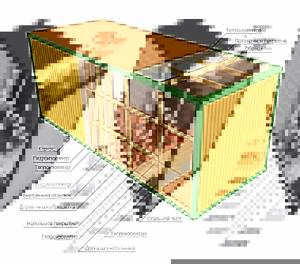
The second method is to attach the insulating sheathing directly to the metal surface. To do this, the metal is thoroughly cleaned of dust and dirt, and then moistened with water so that the polyurethane foam adheres better. Then foam is applied along the contour of the slabs, applied to the wall and held for several minutes.
The material needs a day to dry completely. At the end the walls are finished with plaster. You can determine the water resistance of an insulated container by watering the walls and roof with water.
What affects the value of a home
The most affordable option is to purchase a house made from one container. Such buildings are suitable for country houses for temporary residence. To build a permanent home, you will need several containers, due to which the cost of materials will increase several times depending on the size of the future home.
Affects the final price and number of floors of the house. If you want to make a 2nd floor by adding 2-3 containers on top, construction costs will at least double. A noticeable increase in the cost of future housing is ensured by turning to contractor firms that build houses from sea containers. Additionally, costs are greatly influenced by the territory and conditions under which construction will take place, as well as the type and quality of finishing, soil characteristics, and others.
Types of block containers
The change house can be assembled from scratch, or you can purchase a ready-made shipping container and partially modify it. The first option is good for its variability - you can choose the appropriate sizes, choose convenient equipment for a comfortable stay in the summer. A ready-made container requires much less labor, but its application possibilities are limited.
Another variety has become collapsible modular block containers. Several of these containers can be combined - as a result, you will get the equivalent of a full-fledged summer house with several rooms and a convenient layout. Such products are characterized by mobility and variability of assembly.
Container house project
Shipping containers are popular with architects. People with a creative streak are converting trailers into incredibly beautiful residential structures. Some use such houses as change houses, while others build full-fledged two-story cottages with balconies from containers with their own hands. For construction, blocks 6 meters long and weighing 2200 kg are most often used.
The layout of container housing varies; it is developed for each individual individually. For such buildings, it is important to accurately calculate the possible load. First, future residents must decide on the number of rooms, the floor plan and decide whether the house will have a shower and toilet. To avoid errors in calculations, you can contact specialized companies that develop container house projects. They will take into account the nuances and calculate the amount of materials. The internal part of the block can be divided into compartments of different sizes with the installation of additional doors, windows, hatches.
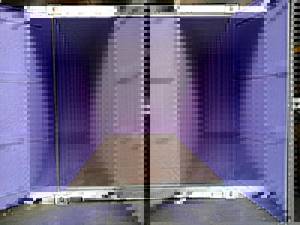
Housing built according to the project will be reliable, durable and beautiful. Sometimes combined plans are made, in which other materials are additionally used during construction. After completing the project drawing, it is sent to production, where blanks are made - windows, doors, floors and others. They are then brought to the construction site, the house is assembled, ventilation is installed and a roof is erected, since containers with a tarpaulin top are often found.
In what version can you buy a block container?
Block containers from the manufacturer, upon agreement with the customer, may have different dimensions and technical parameters; in their design it is permissible to use products and materials other than standard ones, however, it is important to take into account the existing requirements for dimensions when transporting the product and not to deviate from the developed specifications.
Also, at the client’s request, the construction trailer can be additionally equipped with metal doors, grilles and shutters, PVC windows, removable canopies, various furniture, open electrical wiring or electrical wiring installed in a PVC cable channel, heating and heating devices, exhaust or duct fans . A variety of plumbing fixtures (toilets, sinks, urinals, sinks and showers) can be installed in a specially designed metal block container.
From several construction containers combined into a complex, a modular building can be formed. The trailers can be placed on top of each other (up to 3 floors), or arranged horizontally, thereby changing the structure and number of interior spaces.
Each module includes the entire range of life support elements built into standard modules: doors, windows, interior decoration. The structure can also be equipped with additional elements, equipment, and technical systems.
Categories of container buildings
In our company you can buy products of two basic configurations (classes):
- Economy _ In such a solution, simpler versions of materials are used with the expectation of creating basic living and operating conditions;
- Standard . Structures of increased reliability and comfort, designed for long periods and high intensity of use. In the production of these modular buildings, the latest technologies and high-quality designer finishes are used.
The procedure for installing a block container:
- 1. prepare a flat horizontal area;
- 2. disconnect the BC from the vehicle and unload it onto the site using self-propelled or other lifting mechanisms.
Preparation for use of the trailer:
- 1. re-ground the neutral wire;
- 2. connect the BC to the power supply;
- 3. unpack and install equipment removed and secured for the period of transportation.
Transportation of a block container is carried out by road or other means of transport. When moving standard trailers by freight transport, no special permits are required.
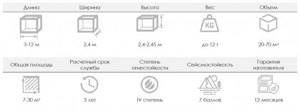
Advantages of metal containers
Construction containers are a metal box. They consist of a welded frame, which is sheathed with profiled sheets. This is a standard design, made using the same technology. Therefore, the production time for construction trailers usually takes 1 – 3 days
.
Since the containers are completely manufactured and assembled at the factory, they arrive at the customer’s site ready-made. They can be used within a couple of hours after delivery.
For insulation, mineral wool or polyurethane foam is used, which are placed in an internal wooden frame. The top is covered with a layer of vapor barrier film. If desired, the insulation layer can be increased to 100 or 150 mm, so the container can be used in any climatic conditions
.
You can separate the vestibule, main room and bathroom or leave one common space. The interior layout of the construction trailer can be any
. It all depends on your tasks. The same applies to equipment with furniture.
The dimensions of block containers are standard; one block fits perfectly on the manipulator platform. So there will be no problems if you want to transport it to a new place after use
.
